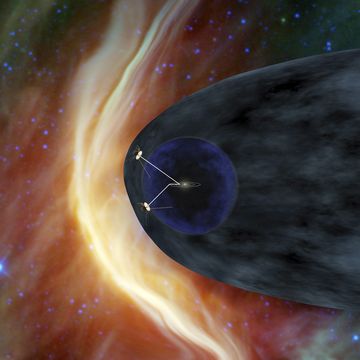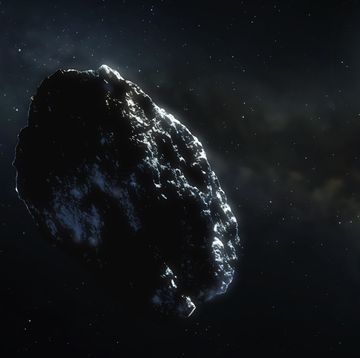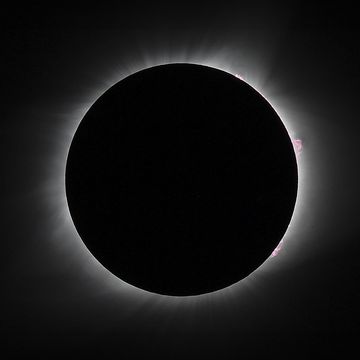NASA's Innovative Advanced Concepts (NIAC) Phase II winning proposals—NASA's most far-out, pie-in-the-sky, preliminary dream plans—are out, and they detail ways we could explore the really the most distant and forbidding areas of our solar system. We're talking long term exploration of Venus' surface, going deep inside lunar caves, traveling to the edge of the solar system, and yes, getting humans to Mars.
All of these are currently on-paper proposals, a few with small scale prototypes made. Which is to say these plans are far from flight ready, but meant to illustrate the feasibility of some pretty far-out plans.
Here's a breakdown:
Heliopause Electrostatic Rapid Transit System (HERTS)
It took the Voyager 1 craft more than 35 years to get to the heliopause, the theoretical boundary where the Sun's solar wind stops. This proposal from Bruce Wiegmann at NASA Marshall Space Flight Center aims to get there again in just a decade and a half. The plan details an electric propulsion method which uses a number of tensile wires that conduct solar particles. This propels the craft along without the need for a rocket propellant and can get it moving fast. Very fast.
Think of it as an advanced solar sail. With such a transport, NASA could move past the icy world of Eris in just shy of a decade, and hit the outer reaches of the solar system in 15 years. It would be moving, on average, 10 AU (astronomical unit, the distance of the sun to the Earth) per year, though it would get more of a boost in the inner solar system where the suns rays are more powerful. According to the Phase I proposal, it could eventually get to speeds of 20-30 AU per year.
It may be just a fraction of the speed of light, but it would be faster than anything we have now and an easy way to study the outer boundary of the sun's influence. It would still take more than 2,000 years to get a light year away, and just under 9,000 years to get to "nearby" star Proxima Centauri.
Titan Submarine: Exploring the Depths of Kraken Mare
We previously covered the Titan Submarine, and are happy to see it move along to Phase II, and with good reason. It's one of the most audacious proposals in a program full of audacious proposals: a way to dive below the depths of one of the most intriguing places in the solar system. Because of how it resembles early Earth, Titan is believed to potentially be a pre-biotic environment that could someday sustain life. That is, if it doesn't already. Some researchers have suggested that it could already have nitrogen-based life.
Titan is one of the easier place in the atmosphere to explore by submarine since its lakes aren't buried under miles of ice. But its a technology that could also be used on Europa, Ganymede, Enceladus, or any other alien place with standing bodies of water. With a little modification, of course.
3D Photocatalytic Air Processor for Dramatic Reduction of Life Support Mass and Complexity
Any future mission to Mars is going to be a big endeavor, and NASA has to cut weight from the payload wherever it can, without endangering Mars-bound astronauts. One of the big weights will be the life support system. Bin Chen of the University of California came up with this solution, using ambient energy in space.
The plan where would be to use the photocatalytic capabilities of titanium dioxide to do things like break down water into hydrogen and oxygen, and purify the air in the process. It's an idea that's been explored not just for space exploration, but for mining safety too. And thanks to titanium's light weight as well these natural capabilities, the whole thing could be lighter, safer, and have fewer moving parts than current solutions.
PERISCOPE: PERIapsis Subsurface Cave Optical Explorer
The moon has a number of "Skylights," caves that open up in the surface, going from a small crater hole to a larger interior cavern. They could be an ideal place to put a future lunar colony since they offer natural shielding from heat and radiation. But before any of that could be done, we'd need to be able to see inside them.
That's where PERISCOPE would come in. Proposed by Jeffrey Nosanov of Nosanov Consulting, LLC, the concept involves using an orbiter to fire a series of lasers into a skylight, helping to map the interior. The observations could then be used to create a 3D map of the caverns, and pave the way for an eventual lunar colony. Similar technologies could be used to map other difficult terrain from orbit without the hassle of having to touch down.
Trans-Formers for Lunar Extreme Environments
The moon is full of dangerous terrain. And in deep craters it's very dark dangerous terrain. The Trans-Formers concept seeks to illuminate that problem. Literally. A small rover trailer would unfurl a giant mirror that could reflect sunlight into a crater and give the rover enough light to get a bearing on its surroundings.
Of course, where there's sunlight, there's heat, and in airless environments like the moon, this could be a tremendous advantage. This would not only give a partly solar-powered rover an extra boost of energy, but also hit it with enough heat to prevent it from freezing up in a dark crater. It could enable new depths of exploration previously unimagined.
SCEPS in Space - Non-Radioisotope Power Systems for Sunless Solar System Exploration Missions
Most rovers and other landers are powered by solar power, which is great for places like Mars but is troublesome for low-or-no light problems, like on a comet. For an orbiting mission like Cassini or a flyby like New Horizons, you can just use nuclear power, but in other environments, contamination is a big problem.
SCEPS stands for Stored Chemical Energy Power Systems, which, as developer Michael Paul of Penn State points out, has been used in Naval torpedoes for decades. By using chemical (rather than nuclear) energy, a probe could explore low light environments. Paul is aiming it toward Venus, where cloud cover prevents sunlight from hitting the surface. There are plenty of dark places in the solar system ripe for exploration, like the moons of the outer solar system.













